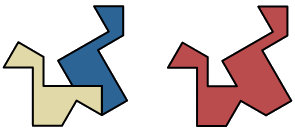Swans tile
Lately, I have been creating new shapes from gaps or voids which are left when placing other tiles such as Bob Nungester's gingerbread man.
It transpires that one of these new shapes (below right) can be made up of two of Bram Cohen's computer generated 'ducks' (below left) which I have named 'swans':
Interestingly, swans can easily tile the plane in a variety of ways, displaying symmetries every which way you look. Mirroring of the polygon doesn't work so it's effectively a single tile.
There are five ways that an 'indent' can be filled:
The first 'enclosure' (above top left) produces at least 17 different coronas (worked out by hand) and all can be expanded. It is reasonable to assume that the other four will produce a similar number:
I added a further three coronas to one of the examples above:
This shape is most impressive when creating two or three-fold radial patterns as they are likely to be different every time.
There are three central core configurations:
Each motif can easily produce periodic tilings. In fact, all three motifs show up in each of the three tessellations if colours are ignored. Only points of origin change:
But much more interesting patterns can also arise:
Same example as above but with alterations on the right hand side to create a 'glitched' or nonuniform radial tiling.
These patterns will contain many rotational symmetries. The top row below are the most common along with the three-fold configurations mentioned earlier.
Here's a two-fold example:
All drawings created with Arnaud Chéritat's applet that now has grouping and multi-tile options. And best of all, it's free for anyone to use.
https://www.math.univ-toulouse.fr/~cheritat/AppletsDivers/Monotile/generic/v3.2/


















Comments
Post a Comment